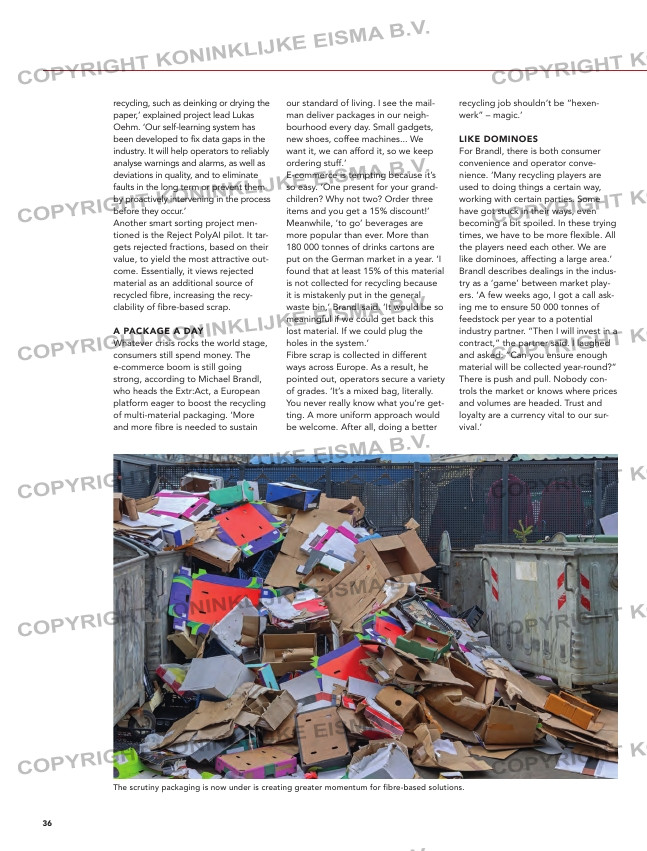Page 36 from: What’s inside?

36
recycling, such as deinking or drying the
paper,’ explained project lead Lukas
Oehm. ‘Our self-learning system has
been developed to fix data gaps in the
industry. It will help operators to reliably
analyse warnings and alarms, as well as
deviations in quality, and to eliminate
faults in the long term or prevent them
by proactively intervening in the process
before they occur.’
Another smart sorting project men-
tioned is the Reject PolyAI pilot. It tar-
gets rejected fractions, based on their
value, to yield the most attractive out-
come. Essentially, it views rejected
material as an additional source of
recycled fibre, increasing the recy-
clability of fibre-based scrap.
A PACKAGE A DAY
Whatever crisis rocks the world stage,
consumers still spend money. The
e-commerce boom is still going
strong, according to Michael Brandl,
who heads the Extr:Act, a European
platform eager to boost the recycling
of multi-material packaging. ‘More
and more fibre is needed to sustain
our standard of living. I see the mail-
man deliver packages in our neigh-
bourhood every day. Small gadgets,
new shoes, coffee machines… We
want it, we can afford it, so we keep
ordering stuff.’
E-commerce is tempting because it’s
so easy. ‘One present for your grand-
children? Why not two? Order three
items and you get a 15% discount!’
Meanwhile, ‘to go’ beverages are
more popular than ever. More than
180 000 tonnes of drinks cartons are
put on the German market in a year. ‘I
found that at least 15% of this material
is not collected for recycling because
it is mistakenly put in the general
waste bin,’ Brandl said. ‘It would be so
meaningful if we could get back this
lost material. If we could plug the
holes in the system.’
Fibre scrap is collected in different
ways across Europe. As a result, he
pointed out, operators secure a variety
of grades. ‘It’s a mixed bag, literally.
You never really know what you’re get-
ting. A more uniform approach would
be welcome. After all, doing a better
recycling job shouldn’t be “hexen-
werk” – magic.’
LIKE DOMINOES
For Brandl, there is both consumer
convenience and operator conve-
nience. ‘Many recycling players are
used to doing things a certain way,
working with certain parties. Some
have got stuck in their ways, even
becoming a bit spoiled. In these trying
times, we have to be more flexible. All
the players need each other. We are
like dominoes, affecting a large area.’
Brandl describes dealings in the indus-
try as a ‘game’ between market play-
ers. ‘A few weeks ago, I got a call ask-
ing me to ensure 50 000 tonnes of
feedstock per year to a potential
industry partner. “Then I will invest in a
contract,” the partner said. I laughed
and asked: “Can you ensure enough
material will be collected year-round?”
There is push and pull. Nobody con-
trols the market or knows where prices
and volumes are headed. Trust and
loyalty are a currency vital to our sur-
vival.’
The scrutiny packaging is now under is creating greater momentum for fibre-based solutions.
30-31-32-34-35-36_globalpapertrends.indd 36 24-04-2024 14:09



